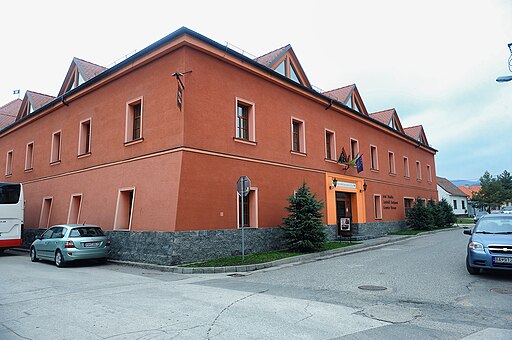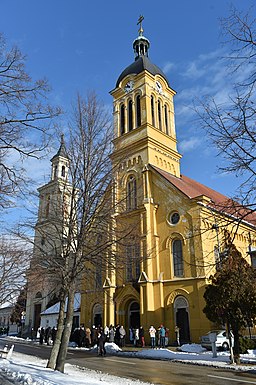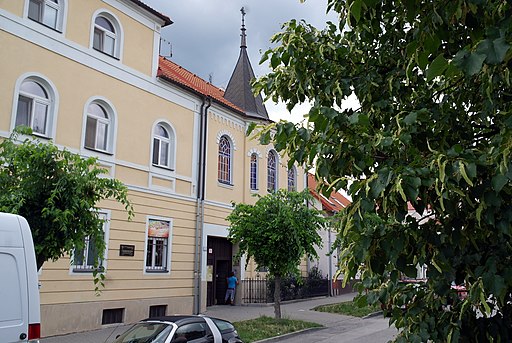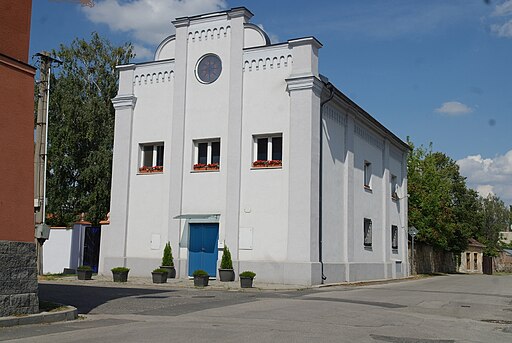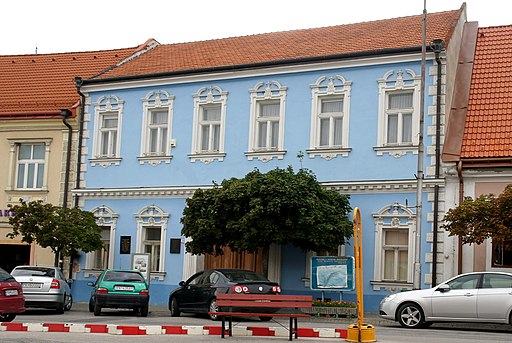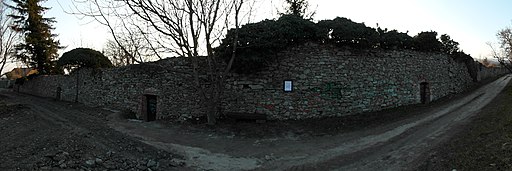Modor
Historical Hungarian county:
Pozsony
District:
Bratislavský kraj
GPS coordinates:
48.335702, 17.311098
Population
Population in 1910
| Total |
5009 |
| Hungarian |
6.93% |
| Slovak |
82.33% |
As early as 1326, it was recorded that the inhabitants of the town at the foot of the Little Carpathians were engaged in viticulture, no wonder that this region has long been famous for its excellent wines. Nothing proves this better than the fact that there is a vine on the right field of its ancient coat of arms. It was granted the status of free royal town in the early 17th century and it was surrounded by walls, some sections of which and one town gate can still be seen. Its inhabitants converted to the Lutheran faith during the Reformation and established a grammar school. The Lutheran presence was so strong that the town became an episcopal seat in 1741. It also became famous for its majolica manufactory, founded in 1883, which can be visited. You cannot reach Modor by train. In 1838, when the horse-drawn railway connecting Pozsony with Nagyszombat was in the planning phase, the representative body of the town of Modor protested, arguing that the railway spreads immorality and sin, so the railway eventually avoided the city. Thirty years later, when the horse-drawn railway was converted into a steam railway, the Modorians offered 60,000 gold to lay the track closer to their city, but their request was not granted.
Check out other towns in Upper Hungary (Slovakia) as well!
895
Arrival of the Hungarians
Little more...
895
The alliance of the seven Hungarian tribes took possession of the then largely uninhabited Carpathian Basin. Until then, the sparse Slavic population of the north-western Carpathians had lived under Moravian rule for a few decades after the collapse of the Avar Khaganate in the early 9th century.
1000
Foundation of the Hungarian Kingdom
Little more...
1000
The Kingdom of Hungary was established with the coronation of King Stephen I. He converted the Hungarians to Christianity and created two archdioceses (Esztergom and Kalocsa) and ten dioceses. He divided Hungary into counties led by ispáns, who were appointed by the king.
12th century
The settlement belonged to Pozsony castle.
1158
It was mentioned for the first time. King Géza II of Hungary gifted it to the Bishopric of Nyitra.
1241-1242
Mongol Invasion
Little more...
1241-1242
The hordes of the Mongol Empire invaded Hungary and almost completely destroyed it. One third to one half of the population was destroyed. The Mongols also suffered heavy losses in the battle of Muhi and they could not hunt down the king. After their withdrawal, King Béla IV reorganized Hungary. He allowed the feudal lords to build stone castles because they were able to successfully resist the nomadic Mongols. The vast majority of stone castles were built after this. The king called in German, Vlach (Romanian) and Slavic settlers to replace the destroyed population.
1241
The Mongol invaders destroyed the settlement.
1301
The extinction of the House of Árpád
Little more...
1301
The House of Árpád, the first Hungarian royal dynasty, died out with the death of King Andrew III. Hungary was ruled by oligarchs, the most powerful of whom was Csák Máté, whose main ally was the Aba family. King Charles I (1308-1342), supported by the Pope, eventually emerged as the most prominent of the contenders for the Hungarian throne. But it took decades to break the power of the oligarchs.
1300-1321
Csák Máté owned the settlement.
1321
With the death of the oligarch Csák Máté the town came under the control of King Charles I of Hungary.
1326
Vine production in the area was mentioned first.
1361
King Louis I of Hungary granted it town privileges.
1526
Battle of Mohács and the splitting of Hungary into two parts
Little more...
1526
Sultan Suleiman I launched a war against Vienna, instigated by the French. Ferdinand I, Duke of Austria, was the brother-in-law of King Louis II of Hungary. The army of the Ottoman Empire defeated the much smaller Hungarian army at Mohács, and King Louis II died in the battle. A group of the barons elected Ferdinand I of the House of Habsburg to the throne, who promised to defend Hungary from the Turks. He was the younger brother of the most powerful European monarch Emperor Charles V. But the nobility chose the most powerful Hungarian baron, Szapolyai János, who was also crowned as King John I. The country was split in two and a decades-long struggle for power began.
1541
The Turkish occupation of the capital, Buda, and the division of Hungary into three parts
Little more...
1541
The Turks conquered Buda, the capital of Hungary, after the death of King John I. The central part of the country was under Turkish rule for 150 years. The western and northern parts (including present-day Slovakia) formed the Kingdom of Hungary ruled by the Habsburg emperors. The eastern parts (now mainly under Romanian rule) were ruled by the successors of King John I of Hungary. In 1571, John II (John Sigismund), the son of King John I of Hungary, renounced the title of King of Hungary in favor of King Maximilian of the House of Habsburg, and henceforth held the title of Prince. This formally created the Principality of Transylvania, which was the eastern half of Hungary not ruled by the Habsburgs and was also a vassal of the Ottoman Empire. John II died in 1571, after which the three nations of Transylvania (the Hungarian nobility, the Székelys and the Saxons) elected the prince.
1741-1934
The town was a Lutheran episcopal seat.
1594
A Lutheran high school was opened.
1604-1606
Uprising of Bocskai István
Little more...
1604-1606
The alliance of the Habsburgs and the Principality of Transylvania was defeated by the Ottoman Empire in the Fifteen Years' War. The war devastated Transylvania, which was occupied by the Habsburg imperial army, and General Basta introduced a reign of terror. The nobility and the burghers were upset about the terror, the plundering mercenaries and the violent Counter-Reformation. Bocskai István decided to lead their uprising after the Habsburg emperor tried to confiscate his estates. Bocskai also rallied the hajdú warriors to his side. He was elected Prince of Transylvania and soon liberated the Kingdom of Hungary from the Habsburgs. In 1605 Bocskai István was crowned King of Hungary with the crown he received from the Turks.
1605
Bocskai István occupied the town.
23 June 1606
Peace of Vienna
Little more...
23 June 1606
Bocski István made peace with Emperor Rudolf. Their agreement secured the constitutional rights of the Estates of Hungary, and the freedom of religion. The counties of Szatmár, Bereg and Ugocsa were annexed to the Principality of Transylvania. Bocskai died of illness in the same year, leaving to his successors the idea of unifying Hungary from Transylvania.
1607
Emperor Rudolf made Modor a free royal town.
1619
The campaign of Prince Bethlen Gábor of Transylvania in the Thirty Years' War
Little more...
1619
At the beginning of the Thirty Years' War (1618-1648), Prince Bethlen Gábor of Transylvania went to war against the Habsburg emperor as an ally of the rebelling Czech-Moravian-Austrian estates. The whole Kingdom of Hungary joined him, only the Austrian defenders of Pozsony had to be put to the sword. With his allies, he laid siege to Vienna. However, he was forced to abandon the siege because the Habsburg-loyal Hungarian aristocrat Homonnai Drugeth György attacked his heartland with Polish mercenaries. On 25 August 1620, the Diet of Besztercebánya elected Bethlen Gábor King of Hungary as vassal of the Turks. He continued to fight after the defeat of the Czechs at White Mountain on 8 November 1620, but without real chance to achieve decisive victory, he decided to come to an agreement with Emperor Ferdinand II.
autumn 1619
The town peacefully surrendered to Prince Bethlen Gábor of Transylvania.
April 29, 1621
Pozsony surrendered to the Imperial army of Buquoy. Modor also surrendered.
31 December 1621
Peace of Nikolsburg
Little more...
31 December 1621
Prince Bethlen Gábor of Transylvania made peace with Emperor Ferdinand II. Their agreement secured the constitutional rights of the Estates of Hungary, and later it was supplemented with the freedom of religion. Bethlen renounced the title of King of Hungary in exchange for seven counties of the Upper Tisza region (Szabolcs, Szatmár, Bereg, Ugocsa, Zemplén, Borsod, Abaúj) for the rest of his life, other estates in Hungary as his private property and the imperial title of Duke of Oppeln and Ratibor (Opole and Racibórz), one of the Duchies of Silesia. Prince Bethlen went to war against the Habsburgs in 1623 and 1626, but was unable to negotiate more favourable terms.
1610-1646
The town was fortified.
1663
The Turkish army that occupied Érsekújvár plundered the town.
1674
The Benedictines established a Catholic high school.
1686
Recapture of Buda and the liberation of Hungary from the Turks
Little more...
1686
The army of the Holy League recaptured Buda from the Turks by siege. In 1687, the Imperial army invaded the Principality of Transylvania. The liberation was hindered by the French breaking their promise of peace in 1688 and attacking the Habsburg Empire. By 1699, when the Peace of Karlóca was signed, all of Hungary and Croatia had been liberated from the Ottoman Empire with the exception of Temesköz, the area bounded by the Maros, the Tisza and the Danube rivers. It was not until the Peace of Požarevac in 1718 that Temesköz was liberated from the Turks. However, the continuous war against the Turkish invaders and the Habsburg autocracy, which lasted for more than 150 years, wiped out large areas of the Hungarian population, which had previously made up 80% of the country's population, and was replaced by Vlachs (Romanians), Serbs and other Slavic settlers and Germans. The Habsburgs also favoured the settlement of these foreign peoples over the 'rebellious' Hungarians.
1703-1711
Hungarian War of Independence led by Prince Rákóczi Ferenc II
Little more...
1703-1711
After the expulsion of the Turks, the Habsburgs treated Hungary as a newly conquered province and did not respect its constitution. The serfs rose up against the Habsburg ruler because of the sufferings caused by the war and the heavy burdens, and they invited Rákóczi Ferenc II to lead them. Trusting in the help promised by King Louis XIV of France, he accepted. Rákóczi rallied the nobility to his side, and soon most of the country was under his control. The rebels were called the kurucs. In 1704, the French and the Bavarians were defeated at the Battle of Blenheim, depriving the Hungarians of their international allies. The Rusyn, Slovak and Vlach peasants and the Saxons of Szepes supported the fight for freedom, while the Serbs in the south and the Saxons in Transylvania served the Habsburgs. Due to lack of funds Rákóczi could not raise a strong regular army, and in 1710, Hungary was also hit by a severe plague. Rákóczi tried unsuccessfully to forge an alliance with Tsar Peter the Great of Russia. In his absence, without his knowledge, his commander-in-chief, Károlyi Sándor, accepted Emperor Joseph I's peace offer. The Peace of Szatmár formally restored the Hungarian constitution and religious freedom and granted amnesty, but did not ease the burden of serfdom. Rákóczi refused to accept the pardon and went into exile. He died in Rodosto, Turkey.
1705, 1729
Fire devastated the important vine producing area.
1848-1849
Hungarian Revolution and War of Independence
Little more...
1848-1849
Following the news of the Paris Revolution on 22 February 1848, the Hungarian liberal opposition led by Kossuth Lajos demanded the abolition of serfdom, the abolition of the tax exemption of the nobility, a parliament elected by the people, and an independent and accountable national government. The revolution that broke out in Pest on 15 March expressed its demands in 12 points, which, in addition to the above mentioned, included the freedom of the press, equality before the law, the release of the political prisoners and the union with Transylvania. A Hungarian government was formed, Batthyány Lajos became prime minister, and on 11 April Emperor Ferdinand V ratified the reform laws. On August 31 the Emperor demanded the repeal of the laws threatening with military intervention. In September the Emperor unleashed the army of Jelacic, Ban of Croatia, on Hungary, but they were defeated by the Hungarians in the Battle of Pákozd on 29 September. An open war began for the independence of Hungary. The Habsburgs incited the nationalities against the Hungarians. The Rusyns, the Slovenes and most of the Slovaks and Germans supported the cause persistently, but the Vlachs (Romanians) and the Serbians turned against the Hungarians. The glorious Spring Campaign in 1849 led by General Görgei Artúr liberated almost all of Hungary. On 1 May 1849, Emperor Franz Joseph, effectively admitting defeat, asked for the help of Tsar Nicholas I of Russia, who sent an intervention army of 200,000 soldiers against Hungary. The resistance became hopeless against the overwhelming enemy forces and on 13 August Görgei Artúr surrendered to the Russians at Világos. Bloody reprisals followed, and on 6 October 1849, 12 generals and a colonel of the Hungarian Revolution, the martyrs of Arad, were executed in Arad. On the same day, Batthyány Lajos, the first Hungarian Prime Minister, was executed by firing squad in Pest. The Habsburgs introduced total authoritarianism in Hungary, but they also failed to fulfil their promises to the nationalities that had betrayed the Hungarians.
1867
Austro-Hungarian Compromise
Little more...
1867
The Habsburg Empire was weakened by the defeats it suffered in the implementation of Italian and German unity. The Hungarians wanted to return to the reform laws of 1848, but they did not have the strength to do so. Emperor Franz Joseph and the Hungarian opposition, led by Deák Ferenc, finally agreed to restructure the Empire and abolish absolutism. Hungary was given autonomy in its internal affairs, with its own government and parliament, which was essential for the development of its economy and culture. However, foreign and military affairs remained in the hands of the Habsburgs and served their aspiration for becoming a great power. The majority wanted Hungary's independence, but they were excluded from political power.
1914-1918
World War I
Little more...
1914-1918
As part of the Austro-Hungarian Monarchy, Hungary took part in the war on the side of the Central Powers.
November 1918 - January 1919
The Czech, Romanian and Serbian occupation of Hungary
Little more...
November 1918 - January 1919
In Hungary, the freemasonic subversion brought the pro-Entente Károlyi Mihály to power. The new government, naively trusting the Entente powers, met all their demands and disbanded the Hungarian military, which rendered the country completely defenseless in the most dire need. Under French and Italian command, Czech, Romanian and Serbian troops invaded large parts of Hungary, where they immediately began the takeover. They fired Hungarian railway workers, officials and teachers, banned the use of the Hungarian language, abolished Hungarian education, and disposed of everything that reminded them of the country's Hungarian past. Hundreds of thousands of Hungarians were forced to leave their homeland, and the forcible assimilation of the remaining Hungarians was begun.
December 8, 1918
The Czechoslovaks invaded Modor.
4 June 1920
Trianon Dictate
Little more...
4 June 1920
Hungary was forced to sign the Treaty of Trianon, although the country was not invited to the peace talks. Hungary lost two thirds of its territory that had belonged to it for more than 1000 years. One-third of the Hungarian population came under foreign rule. On the basis of the national principle, countries with a more mixed and less ethnically balanced composition than the former Hungary were created, such as Czechoslovakia and the Kingdom of Serbs, Croats and Slovenes (later Yugoslavia). For example, while 48% of the population of the territory ceded to Czechoslovakia was Slovak and 30% Hungarian, 54% of the population of the former Hungary was Hungarian and 10.6% Slovak. And in the territory that is now part of Serbia, the Hungarians outnumbered the Serbs. The part of the territory allocated to Romania from Hungary was larger than the remaining territory of Hungary, despite the fact that there were 10 million Hungarians and less than 3 million Romanians in the former Hungary. While Hungary used to have the most liberal nationality policy in Europe, the successor states had no respect at all for the national and cultural rights of the indigenous Hungarians and engaged in forced assimilation. The Trianon Dictate destroyed the organic economic unity of the region. Before the First World War, Hungary had a dynamic economy, more advanced than Spain's. After 1920, the successor states formed the so-called "Little Entente", putting Hungary under an economic blockade and sabotaging it on the international stage.
14 March 1939
First independent Slovakia was established
Little more...
14 March 1939
The first independent Slovakia was established under German patronage. Josef Tiso became president of the country. In 1938, Hungary regained 11,927 km2 of territory from Czechoslovakia under the First Vienna Award. Its population was 869 thousand people, 86.5% of whom were Hungarian. From the remaining territory that Hungary did not get back, Slovakia was formed.
Autumn 1944 - Spring 1945
Soviet occupation
Little more...
Autumn 1944 - Spring 1945
The Soviet Red Army occupied Hungary and Slovakia, which resulted in the recreation of Czechoslovakia.
5 April 1945
Beneš decrees and the persecution of Hungarians
Little more...
5 April 1945
In Hungarian-majority Kassa, the president of occupying Czechoslovakia, Edvard Beneš, promulgated his government program, the so-called Beneš decrees. As part of this, the Hungarian population was deprived of their rights. Their complete expulsion was planned, with the support of the Soviet Union, and only the veto of the USA prevented it. Under the 'Reslavakization' programme, only those Hungarians who recognised themselves as Slovaks were allowed to regain their rights, thus renouncing all linguistic and cultural rights. In the violent expulsions that followed, nearly 200,000 Hungarians were deprived of their property and expelled from their homeland on the basis of their nationality.
1 January 1993
Dissolution of Czechoslovakia
Little more...
1 January 1993
Czechoslovakia disintegrated due to ethnic differences between Czechs and Slovaks, shortly after the withdrawal of Soviet tanks. Slovakia was formed entirely from territory carved out of historic Hungary, and Slovak national identity is still largely based on falsified history and artificial hatred of Hungarians. Despite deportations, expulsions, forced assimilation and strong economic pressure, there are still nearly half a million Hungarians living in the country.
Sights
All
Churches, religious buildings
Public buildings
Cultural facilities
Commerce, industry, hospitality
Town infrastructure
Private buildings
Memorials
Museums and Galleries
Churches, religious buildings
Saint Stephen of Hungary Roman Catholic Church
Kostol sv. Štefana kráľa
Show on map
Visit
Saint Stephen of Hungary Roman Catholic Church
History
The church was built in 1873 in Classicist-Renaissance style according to the plans of Feigler Ignác. They started to build the tower in 1574. It was originally a guard tower and was used for signaling natural disasters and approaching enemies. It had 4 bells and a clock was also installed in 1731. It is 53 meters high. The tower was incorporated into the newly built Church of Saint Stephen as its bell tower between 1873 and 1876. St. Stephen was the first Christian king of Hungary between 1000 and 1038.
St. John the Baptist Roman Catholic Church
Kostol Narodenia sv. Jána Krstiteľa
Show on map
Visit
St. John the Baptist Roman Catholic Church
History
It was built in the 14th century in Gothic style. It was expanded in the 16th and 17th centuries.
German Lutheran church
Nemecký evanjelický kostol a. v.
Show on map
Visit
German Lutheran church
History
The neo-Classicist church was built between 1833 and 1834. It gained its current form in 1866.
Slovak Lutheran church
Slovenský evanjelický a. v. kostol Modra
Show on map
Visit
Slovak Lutheran church
History
It was built between 1825 and 1835.
Chapel of Saint Mary of the Snow
Kaplnka Panny Márie Snežnej
Show on map
Visit
Chapel of Saint Mary of the Snow
History
It was a baptistery built in 1760. The feast of Saint Mary of the Snow is on August 5.
Trinity Chapel
Show on map
Visit
Calvary
Kalvária
Show on map
Visit
former Ursuline Nunnery
Kláštor Uršulínok (Claudianum, Štúrova 34)
Originally:
monastery / nunnery / canon's house / provost residence, school
Show on map
Visit
former Ursuline Nunnery
History
The nunnery and the school was founded in 1901 by the Ursuline nuns of Nyitra in order to educate Catholic girls. The building was constructed by Bishop Vaszary Kolos Ferenc of Esztergom.
Synagogue
Synagóga
Show on map
Visit
Public buildings
Town Hall
Radnica
Show on map
Visit
Town Hall
History
Modor was granted the status of free royal town in 1607 by King Rudolf I of Hungary. Afterwards a Renaissance town hall was created. It was renovated between 1830 and 1837 and also in the 60s and 70s of the 20th century. It has a wine cellar, where the wine barrels submitted as tax were stored.
Cultural facilities
Lutheran Grammar School
Evanjelické gymnázium
Show on map
Visit
Lutheran Grammar School
History
The Lutheran grammar school was established in 1610. In 1674 the school was closed because of the Counter-Reformation, but it was allowed to be reopened in 1691 outside of town. The current building was constructed in 1825.
former Hungarian Royal State Teacher Training Academy
Pedagogická a kultúrna akadémia
Originally:
university / college
Currently:
university / college
Note:
Teacher Training College.
Show on map
Visit
former Hungarian Royal State Teacher Training Academy
History
It was built between 1884 and 1887.
Commerce, industry, hospitality
Old Majolika Factory
Hotel Majolika
Currently:
hotel / tavern / guesthouse
Show on map
Visit
Old Majolika Factory
History
It was established in 1883.
Emresz House, Ľudovít Štúr Museum
Emreszovský dom
Originally:
wine house / winery
Show on map
Visit
Emresz House, Ľudovít Štúr Museum
History
Originally it was a Renaissance wine house. In the 19th century it became the property of the Emresz family.
Town infrastructure
Upper Gate
Horná brána
Show on map
Visit
Upper Gate
History
It was built between 1610 and 1618. It was protected by moat, drawbridge and loopholes.
Renaissance Bastion, Exhibition of the Slovak National Gallery
Modranská bašta
Originally:
town fortification
Show on map
Visit
Renaissance Bastion, Exhibition of the Slovak National Gallery
History
Town Walls
Hradby
Originally:
town fortification
Currently:
town fortification
Show on map
Visit
Town Walls
History
The walls of the town were built between 1610 and 1646 after the town was granted the status of free royal town by King Rudolf I of Hungary in 1607. It had 3 gates. Only the northern Upper Gate, some short sections of the wall and a round bastion that was turned into a pub was preserved by now.
Fountain of St. Florian
Kamenná studňa so sochou sv. Floriána
Show on map
Visit
Fountain of St. Florian
History
It was built in 1752. It is now in front of the grammar school, but it stood originally elsewhere.
Private buildings
Castle
Kaštieľ + záhrada (smer Kráľová)
Originally:
mansion / manor house
Currently:
seat of an institution
Note:
Small Carpathian Wine Route Association
Show on map
Visit
Castle
History
It is now a school of horticulture and viniculture. The castle was built in the end of the 16th century. At the beginning of the 20th century the Habsburgs turned it into a pseudo-Renaissance summer hunting lodge.
Memorials
Golgota Statues
Originally:
statue / memorial / relief
Currently:
statue / memorial / relief
Show on map
Visit
Golgota Statues
History
It was erected in the 18th century. The statue of Christ is surrounded by the statues of Virgin Mary, John the Evangelist and Mary Magdalena.
Statue of St. John of Nepomuk
Socha sv. Jána Nepomuckého
Originally:
statue / memorial / relief
Currently:
statue / memorial / relief
Show on map
Visit
Statue of St. John of Nepomuk
History
Museums and Galleries
Renaissance Bastion, Exhibition of the Slovak National Gallery
Modranská bašta
Originally:
town fortification
Show on map
Visit
Renaissance Bastion, Exhibition of the Slovak National Gallery
History
Emresz House, Ľudovít Štúr Museum
Emreszovský dom
Originally:
wine house / winery
Show on map
Visit
Emresz House, Ľudovít Štúr Museum
History
Originally it was a Renaissance wine house. In the 19th century it became the property of the Emresz family.
{"item":"town","set":{"mapcenter":{"lat":"48.3357020000","long":"17.3110980000"},"townlink":"modor-modra","town":{"townId":24,"active":1,"name_HU":"Modor","name_LO":"Modra","name_GE":"Modern","name_LT":"Modorinum","seolink":"modor-modra","listorder":35,"oldcounty":1,"country":2,"division":1,"altitude":"175","gps_lat":"48.3357020000","gps_long":"17.3110980000","population":9,"hungarian_2011":0,"population_1910":5009,"hungarian_1910":6.93,"german_1910":0,"slovak_1910":82.33,"romanian_1910":0,"rusin_1910":0,"serbian_1910":0,"croatian_1910":0,"slovenian_1910":0,"coatofarms":"","coatofarms_ref":"","picture":"\u003Ca title=\u0022\u0412\u0430\u043b\u0435\u0440\u0438\u0439 \u0414\u0435\u0434 \/ CC BY (https:\/\/creativecommons.org\/licenses\/by\/3.0)\u0022 href=\u0022https:\/\/commons.wikimedia.org\/wiki\/File:Modra_2014_-_panoramio_(1).jpg\u0022\u003E\u003Cimg width=\u0022512\u0022 alt=\u0022Modra 2014 - panoramio (1)\u0022 src=\u0022https:\/\/upload.wikimedia.org\/wikipedia\/commons\/thumb\/e\/ed\/Modra_2014_-_panoramio_%281%29.jpg\/512px-Modra_2014_-_panoramio_%281%29.jpg\u0022\u003E\u003C\/a\u003E","picture_ref":"\u003Ca href=\u0022https:\/\/commons.wikimedia.org\/wiki\/File:Modra_2014_-_panoramio_(1).jpg\u0022 title=\u0022via Wikimedia Commons\u0022\u003E\u0412\u0430\u043b\u0435\u0440\u0438\u0439 \u0414\u0435\u0434\u003C\/a\u003E \/ \u003Ca href=\u0022https:\/\/creativecommons.org\/licenses\/by\/3.0\u0022\u003ECC BY\u003C\/a\u003E","georegion":"Little Carpathians","river":"","description":" As early as 1326, it was recorded that the inhabitants of the town at the foot of the Little Carpathians were engaged in viticulture, no wonder that this region has long been famous for its excellent wines. Nothing proves this better than the fact that there is a vine on the right field of its ancient coat of arms. It was granted the status of free royal town in the early 17th century and it was surrounded by walls, some sections of which and one town gate can still be seen. Its inhabitants converted to the Lutheran faith during the Reformation and established a grammar school. The Lutheran presence was so strong that the town became an episcopal seat in 1741. It also became famous for its majolica manufactory, founded in 1883, which can be visited. You cannot reach Modor by train. In 1838, when the horse-drawn railway connecting Pozsony with Nagyszombat was in the planning phase, the representative body of the town of Modor protested, arguing that the railway spreads immorality and sin, so the railway eventually avoided the city. Thirty years later, when the horse-drawn railway was converted into a steam railway, the Modorians offered 60,000 gold to lay the track closer to their city, but their request was not granted.","nameorigin":" The name of the town is an old Hungarian name, \u0022Modor\u0022.","history":"#1|@#3|@12th century|The settlement belonged to Pozsony castle.@1158|It was mentioned for the first time. King G\u00e9za II of Hungary gifted it to the Bishopric of Nyitra.@#5|@1241|The Mongol invaders destroyed the settlement.@#6|@1300-1321|Cs\u00e1k M\u00e1t\u00e9 owned the settlement.@1321|With the death of the oligarch Cs\u00e1k M\u00e1t\u00e9 the town came under the control of King Charles I of Hungary.@1326|Vine production in the area was mentioned first.@1361|King Louis I of Hungary granted it town privileges.@#8|@#11|@1741-1934|The town was a Lutheran episcopal seat.@1594|A Lutheran high school was opened.@#13|@1605|Bocskai Istv\u00e1n occupied the town.@#14|@1607|Emperor Rudolf made Modor a free royal town.@#15|@autumn 1619|The town peacefully surrendered to Prince Bethlen G\u00e1bor of Transylvania.@April 29, 1621|Pozsony surrendered to the Imperial army of Buquoy. Modor also surrendered.@#16|@1610-1646|The town was fortified.@1663|The Turkish army that occupied \u00c9rsek\u00fajv\u00e1r plundered the town.@1674|The Benedictines established a Catholic high school.@#25|@#27|@1705, 1729|Fire devastated the important vine producing area.@#28|@#30|@#31|@#32|@December 8, 1918|The Czechoslovaks invaded Modor.@#36|@#38|@#41|@#42|@#44|&"},"sights":[{"sightId":419,"townId":24,"active":1,"name_LO":"Kostol Narodenia sv. J\u00e1na Krstite\u013ea","address":"Doln\u00e1 56\/78, 900 01 Modra","mapdata":"1|1042|1058","gps_lat":"48.3291970000","gps_long":"17.3135560000","religion":1,"oldtype":"1","newtype":"1","homepage":"","openinghours":"","muemlekemlink":"","csemadoklink":"\r","picture":"\u003Ca title=\u0022Renardo la vulpo \/ CC BY-SA (https:\/\/creativecommons.org\/licenses\/by-sa\/4.0)\u0022 href=\u0022https:\/\/commons.wikimedia.org\/wiki\/File:Modra,_pre%C4%9Dejo_je_Johano_la_baptisto,_19.jpeg\u0022\u003E\u003Cimg width=\u0022512\u0022 alt=\u0022Modra, pre\u011dejo je Johano la baptisto, 19\u0022 src=\u0022https:\/\/upload.wikimedia.org\/wikipedia\/commons\/thumb\/a\/af\/Modra%2C_pre%C4%9Dejo_je_Johano_la_baptisto%2C_19.jpeg\/512px-Modra%2C_pre%C4%9Dejo_je_Johano_la_baptisto%2C_19.jpeg\u0022\u003E\u003C\/a\u003E","picture_ref":"\u003Ca href=\u0022https:\/\/commons.wikimedia.org\/wiki\/File:Modra,_pre%C4%9Dejo_je_Johano_la_baptisto,_19.jpeg\u0022 title=\u0022via Wikimedia Commons\u0022\u003ERenardo la vulpo\u003C\/a\u003E \/ \u003Ca href=\u0022https:\/\/creativecommons.org\/licenses\/by-sa\/4.0\u0022\u003ECC BY-SA\u003C\/a\u003E","name":"St. John the Baptist Roman Catholic Church","seolink":"st-john-the-baptist-roman-catholic-church","note":"","history":"It was built in the 14th century in Gothic style. It was expanded in the 16th and 17th centuries."},{"sightId":420,"townId":24,"active":2,"name_LO":"Kostol sv. \u0160tefana kr\u00e1\u013ea","address":"\u0160t\u00farova 1\/58, 900 01 Modra","mapdata":"1|893|503","gps_lat":"48.3355260000","gps_long":"17.3110850000","religion":1,"oldtype":"1","newtype":"1","homepage":"","openinghours":"","muemlekemlink":"","csemadoklink":"\n","picture":"\u003Ca title=\u0022horakvlado \/ CC BY-SA (https:\/\/creativecommons.org\/licenses\/by-sa\/3.0)\u0022 href=\u0022https:\/\/commons.wikimedia.org\/wiki\/File:Kostol_r.k._sv._%C5%A0tefana_kr%C3%A1%C4%BEa_%C5%A0t%C3%BArova_57_Modra_2.JPG\u0022\u003E\u003Cimg width=\u0022256\u0022 alt=\u0022Kostol r.k. sv. \u0160tefana kr\u00e1\u013ea \u0160t\u00farova 57 Modra 2\u0022 src=\u0022https:\/\/upload.wikimedia.org\/wikipedia\/commons\/thumb\/8\/80\/Kostol_r.k._sv._%C5%A0tefana_kr%C3%A1%C4%BEa_%C5%A0t%C3%BArova_57_Modra_2.JPG\/256px-Kostol_r.k._sv._%C5%A0tefana_kr%C3%A1%C4%BEa_%C5%A0t%C3%BArova_57_Modra_2.JPG\u0022\u003E\u003C\/a\u003E","picture_ref":"\u003Ca href=\u0022https:\/\/commons.wikimedia.org\/wiki\/File:Kostol_r.k._sv._%C5%A0tefana_kr%C3%A1%C4%BEa_%C5%A0t%C3%BArova_57_Modra_2.JPG\u0022 title=\u0022via Wikimedia Commons\u0022\u003Ehorakvlado\u003C\/a\u003E \/ \u003Ca href=\u0022https:\/\/creativecommons.org\/licenses\/by-sa\/3.0\u0022\u003ECC BY-SA\u003C\/a\u003E","name":"Saint Stephen of Hungary Roman Catholic Church","seolink":"saint-stephen-of-hungary--roman-catholic-church","note":"","history":"The church was built in 1873 in Classicist-Renaissance style according to the plans of Feigler Ign\u00e1c. They started to build the tower in 1574. It was originally a guard tower and was used for signaling natural disasters and approaching enemies. It had 4 bells and a clock was also installed in 1731. It is 53 meters high. The tower was incorporated into the newly built Church of Saint Stephen as its bell tower between 1873 and 1876. St. Stephen was the first Christian king of Hungary between 1000 and 1038."},{"sightId":421,"townId":24,"active":1,"name_LO":"Nemeck\u00fd evanjelick\u00fd kostol a. v.","address":"1046 1, 900 01 Modra","mapdata":"1|975|734","gps_lat":"48.3327850000","gps_long":"17.3120940000","religion":3,"oldtype":"1","newtype":"1","homepage":"","openinghours":"","muemlekemlink":"","csemadoklink":"\r","picture":"\u003Ca title=\u0022fe\u0165our \/ Public domain\u0022 href=\u0022https:\/\/commons.wikimedia.org\/wiki\/File:Modra_German_and_Slovak_Lutheran_Church_01.jpg\u0022\u003E\u003Cimg width=\u0022512\u0022 alt=\u0022Modra German and Slovak Lutheran Church 01\u0022 src=\u0022https:\/\/upload.wikimedia.org\/wikipedia\/commons\/thumb\/a\/a9\/Modra_German_and_Slovak_Lutheran_Church_01.jpg\/512px-Modra_German_and_Slovak_Lutheran_Church_01.jpg\u0022\u003E\u003C\/a\u003E","picture_ref":"\u003Ca href=\u0022https:\/\/commons.wikimedia.org\/wiki\/File:Modra_German_and_Slovak_Lutheran_Church_01.jpg\u0022 title=\u0022via Wikimedia Commons\u0022\u003Efe\u0165our\u003C\/a\u003E \/ Public domain","name":"German Lutheran church ","seolink":"german-lutheran-church","note":"","history":"The neo-Classicist church was built between 1833 and 1834. It gained its current form in 1866."},{"sightId":422,"townId":24,"active":1,"name_LO":"Slovensk\u00fd evanjelick\u00fd a. v. kostol Modra","address":"Doln\u00e1 159, 900 01 Modra","mapdata":"1|980|758","gps_lat":"48.3325070000","gps_long":"17.3121550000","religion":3,"oldtype":"1","newtype":"1","homepage":"","openinghours":"","muemlekemlink":"","csemadoklink":"\r","picture":"\u003Ca title=\u0022Pavol Fre\u0161o \/ CC BY (https:\/\/creativecommons.org\/licenses\/by\/2.0)\u0022 href=\u0022https:\/\/commons.wikimedia.org\/wiki\/File:Slovensk%C3%BD_evanjelick%C3%BD_kostol,_Modra.jpg\u0022\u003E\u003Cimg width=\u0022256\u0022 alt=\u0022Slovensk\u00fd evanjelick\u00fd kostol, Modra\u0022 src=\u0022https:\/\/upload.wikimedia.org\/wikipedia\/commons\/thumb\/a\/ac\/Slovensk%C3%BD_evanjelick%C3%BD_kostol%2C_Modra.jpg\/256px-Slovensk%C3%BD_evanjelick%C3%BD_kostol%2C_Modra.jpg\u0022\u003E\u003C\/a\u003E","picture_ref":"\u003Ca href=\u0022https:\/\/commons.wikimedia.org\/wiki\/File:Slovensk%C3%BD_evanjelick%C3%BD_kostol,_Modra.jpg\u0022 title=\u0022via Wikimedia Commons\u0022\u003EPavol Fre\u0161o\u003C\/a\u003E \/ \u003Ca href=\u0022https:\/\/creativecommons.org\/licenses\/by\/2.0\u0022\u003ECC BY\u003C\/a\u003E","name":"Slovak Lutheran church ","seolink":"slovak-lutheran-church","note":"","history":"It was built between 1825 and 1835."},{"sightId":423,"townId":24,"active":1,"name_LO":"Horn\u00e1 br\u00e1na","address":"\u0160t\u00farova 268, 900 01 Modra","mapdata":"1|857|201","gps_lat":"48.3387850000","gps_long":"17.3102950000","religion":0,"oldtype":"23","newtype":"23","homepage":"","openinghours":"","muemlekemlink":"https:\/\/www.muemlekem.hu\/hatareset\/Varoskapu-varosfalak-Modor-1232","csemadoklink":"\r","picture":"\u003Ca title=\u0022horakvlado \/ CC BY-SA (https:\/\/creativecommons.org\/licenses\/by-sa\/3.0)\u0022 href=\u0022https:\/\/commons.wikimedia.org\/wiki\/File:Br%C3%A1na_opevnenia_-_Horn%C3%A1_br%C3%A1na,_%C5%A0t%C3%BArova_128,_Modra.JPG\u0022\u003E\u003Cimg width=\u0022256\u0022 alt=\u0022Br\u00e1na opevnenia - Horn\u00e1 br\u00e1na, \u0160t\u00farova 128, Modra\u0022 src=\u0022https:\/\/upload.wikimedia.org\/wikipedia\/commons\/thumb\/2\/26\/Br%C3%A1na_opevnenia_-_Horn%C3%A1_br%C3%A1na%2C_%C5%A0t%C3%BArova_128%2C_Modra.JPG\/256px-Br%C3%A1na_opevnenia_-_Horn%C3%A1_br%C3%A1na%2C_%C5%A0t%C3%BArova_128%2C_Modra.JPG\u0022\u003E\u003C\/a\u003E","picture_ref":"\u003Ca href=\u0022https:\/\/commons.wikimedia.org\/wiki\/File:Br%C3%A1na_opevnenia_-_Horn%C3%A1_br%C3%A1na,_%C5%A0t%C3%BArova_128,_Modra.JPG\u0022 title=\u0022via Wikimedia Commons\u0022\u003Ehorakvlado\u003C\/a\u003E \/ \u003Ca href=\u0022https:\/\/creativecommons.org\/licenses\/by-sa\/3.0\u0022\u003ECC BY-SA\u003C\/a\u003E","name":"Upper Gate ","seolink":"upper-gate","note":"","history":"It was built between 1610 and 1618. It was protected by moat, drawbridge and loopholes."},{"sightId":424,"townId":24,"active":1,"name_LO":"Kaplnka Panny M\u00e1rie Sne\u017enej","address":"Doln\u00e1 2","mapdata":"1|947|730","gps_lat":"48.3329730000","gps_long":"17.3118310000","religion":1,"oldtype":"2","newtype":"2","homepage":"","openinghours":"","muemlekemlink":"","csemadoklink":"\r","picture":"\u003Ca title=\u0022\u0412\u0430\u043b\u0435\u0440\u0438\u0439 \u0414\u0435\u0434 \/ CC BY (https:\/\/creativecommons.org\/licenses\/by\/3.0)\u0022 href=\u0022https:\/\/commons.wikimedia.org\/wiki\/File:R%C3%ADmskokatol%C3%ADcka_barokov%C3%A1_kaplnka_Panny_M%C3%A1rie_Sne%C5%BEnej_-_panoramio.jpg\u0022\u003E\u003Cimg width=\u0022512\u0022 alt=\u0022R\u00edmskokatol\u00edcka barokov\u00e1 kaplnka Panny M\u00e1rie Sne\u017enej - panoramio\u0022 src=\u0022https:\/\/upload.wikimedia.org\/wikipedia\/commons\/thumb\/6\/6d\/R%C3%ADmskokatol%C3%ADcka_barokov%C3%A1_kaplnka_Panny_M%C3%A1rie_Sne%C5%BEnej_-_panoramio.jpg\/512px-R%C3%ADmskokatol%C3%ADcka_barokov%C3%A1_kaplnka_Panny_M%C3%A1rie_Sne%C5%BEnej_-_panoramio.jpg\u0022\u003E\u003C\/a\u003E","picture_ref":"\u003Ca href=\u0022https:\/\/commons.wikimedia.org\/wiki\/File:R%C3%ADmskokatol%C3%ADcka_barokov%C3%A1_kaplnka_Panny_M%C3%A1rie_Sne%C5%BEnej_-_panoramio.jpg\u0022 title=\u0022via Wikimedia Commons\u0022\u003E\u0412\u0430\u043b\u0435\u0440\u0438\u0439 \u0414\u0435\u0434\u003C\/a\u003E \/ \u003Ca href=\u0022https:\/\/creativecommons.org\/licenses\/by\/3.0\u0022\u003ECC BY\u003C\/a\u003E","name":"Chapel of Saint Mary of the Snow ","seolink":"chapel-of-saint-mary-of-the-snow","note":"","history":"It was a baptistery built in 1760. The feast of Saint Mary of the Snow is on August 5."},{"sightId":425,"townId":24,"active":1,"name_LO":"Ka\u0161tie\u013e + z\u00e1hrada (smer Kr\u00e1\u013eov\u00e1)","address":"Horn\u00e1 20","mapdata":"1|906|23","gps_lat":"48.3408550000","gps_long":"17.3110220000","religion":0,"oldtype":"51","newtype":"16","homepage":"https:\/\/mvc.sk\/","openinghours":"","muemlekemlink":"","csemadoklink":"\r","picture":"\u003Ca title=\u0022horakvlado \/ CC BY-SA (https:\/\/creativecommons.org\/licenses\/by-sa\/3.0)\u0022 href=\u0022https:\/\/commons.wikimedia.org\/wiki\/File:Ka%C5%A1tie%C4%BE_Horn%C3%A1_20_Modra.JPG\u0022\u003E\u003Cimg width=\u0022512\u0022 alt=\u0022Ka\u0161tie\u013e Horn\u00e1 20 Modra\u0022 src=\u0022https:\/\/upload.wikimedia.org\/wikipedia\/commons\/thumb\/d\/d4\/Ka%C5%A1tie%C4%BE_Horn%C3%A1_20_Modra.JPG\/512px-Ka%C5%A1tie%C4%BE_Horn%C3%A1_20_Modra.JPG\u0022\u003E\u003C\/a\u003E","picture_ref":"\u003Ca href=\u0022https:\/\/commons.wikimedia.org\/wiki\/File:Ka%C5%A1tie%C4%BE_Horn%C3%A1_20_Modra.JPG\u0022 title=\u0022via Wikimedia Commons\u0022\u003Ehorakvlado\u003C\/a\u003E \/ \u003Ca href=\u0022https:\/\/creativecommons.org\/licenses\/by-sa\/3.0\u0022\u003ECC BY-SA\u003C\/a\u003E","name":"Castle","seolink":"castle","note":"Small Carpathian Wine Route Association","history":"It is now a school of horticulture and viniculture. The castle was built in the end of the 16th century. At the beginning of the 20th century the Habsburgs turned it into a pseudo-Renaissance summer hunting lodge."},{"sightId":426,"townId":24,"active":1,"name_LO":"Modransk\u00e1 ba\u0161ta","address":"N\u00e1mestie Slobody 3","mapdata":"1|710|469","gps_lat":"48.3359030000","gps_long":"17.3076960000","religion":0,"oldtype":"24","newtype":"99","homepage":"https:\/\/www.snm.sk\/?galeria-ignaca-bizmayera-uvodna-stranka","openinghours":"","muemlekemlink":"","csemadoklink":"\r","picture":"\u003Ca title=\u0022horakvlado \/ CC BY-SA (https:\/\/creativecommons.org\/licenses\/by-sa\/3.0)\u0022 href=\u0022https:\/\/commons.wikimedia.org\/wiki\/File:Ba%C5%A1ta_mestsk%C3%A9ho_opevnenia_n%C3%A1m._Slobody_3,_Modra_4.JPG\u0022\u003E\u003Cimg width=\u0022512\u0022 alt=\u0022Ba\u0161ta mestsk\u00e9ho opevnenia n\u00e1m. Slobody 3, Modra 4\u0022 src=\u0022https:\/\/upload.wikimedia.org\/wikipedia\/commons\/thumb\/6\/62\/Ba%C5%A1ta_mestsk%C3%A9ho_opevnenia_n%C3%A1m._Slobody_3%2C_Modra_4.JPG\/512px-Ba%C5%A1ta_mestsk%C3%A9ho_opevnenia_n%C3%A1m._Slobody_3%2C_Modra_4.JPG\u0022\u003E\u003C\/a\u003E","picture_ref":"\u003Ca href=\u0022https:\/\/commons.wikimedia.org\/wiki\/File:Ba%C5%A1ta_mestsk%C3%A9ho_opevnenia_n%C3%A1m._Slobody_3,_Modra_4.JPG\u0022 title=\u0022via Wikimedia Commons\u0022\u003Ehorakvlado\u003C\/a\u003E \/ \u003Ca href=\u0022https:\/\/creativecommons.org\/licenses\/by-sa\/3.0\u0022\u003ECC BY-SA\u003C\/a\u003E","name":"Renaissance Bastion, Exhibition of the Slovak National Gallery","seolink":"renaissance-bastion-exhibition-of-the-slovak-national-gallery","note":"","history":""},{"sightId":427,"townId":24,"active":1,"name_LO":"Emreszovsk\u00fd dom","address":"\u0160t\u00farova 84","mapdata":"1|872|391","gps_lat":"48.3368150000","gps_long":"17.3106310000","religion":0,"oldtype":"115","newtype":"98","homepage":"","openinghours":"","muemlekemlink":"","csemadoklink":"\r","picture":"\u003Ca title=\u0022horakvlado \/ CC BY-SA (https:\/\/creativecommons.org\/licenses\/by-sa\/3.0)\u0022 href=\u0022https:\/\/commons.wikimedia.org\/wiki\/File:Dom_me%C5%A1tiansky_pam%C3%A4tn%C3%BD_%C5%A0t%C3%BArova_84_Modra.JPG\u0022\u003E\u003Cimg width=\u0022512\u0022 alt=\u0022Dom me\u0161tiansky pam\u00e4tn\u00fd \u0160t\u00farova 84 Modra\u0022 src=\u0022https:\/\/upload.wikimedia.org\/wikipedia\/commons\/thumb\/0\/08\/Dom_me%C5%A1tiansky_pam%C3%A4tn%C3%BD_%C5%A0t%C3%BArova_84_Modra.JPG\/512px-Dom_me%C5%A1tiansky_pam%C3%A4tn%C3%BD_%C5%A0t%C3%BArova_84_Modra.JPG\u0022\u003E\u003C\/a\u003E","picture_ref":"\u003Ca href=\u0022https:\/\/commons.wikimedia.org\/wiki\/File:Dom_me%C5%A1tiansky_pam%C3%A4tn%C3%BD_%C5%A0t%C3%BArova_84_Modra.JPG\u0022 title=\u0022via Wikimedia Commons\u0022\u003Ehorakvlado\u003C\/a\u003E \/ \u003Ca href=\u0022https:\/\/creativecommons.org\/licenses\/by-sa\/3.0\u0022\u003ECC BY-SA\u003C\/a\u003E","name":"Emresz House, \u013dudov\u00edt \u0160t\u00far Museum","seolink":"emresz-house--ludovit-stur-museum","note":"","history":"Originally it was a Renaissance wine house. In the 19th century it became the property of the Emresz family."},{"sightId":428,"townId":24,"active":1,"name_LO":"Evanjelick\u00e9 gymn\u00e1zium","address":"Doln\u00e1 24","mapdata":"1|940|812","gps_lat":"48.3320050000","gps_long":"17.3117340000","religion":3,"oldtype":"74","newtype":"120","homepage":"","openinghours":"","muemlekemlink":"","csemadoklink":"\r","picture":"\u003Ca title=\u0022horakvlado \/ CC BY-SA (https:\/\/creativecommons.org\/licenses\/by-sa\/3.0)\u0022 href=\u0022https:\/\/commons.wikimedia.org\/wiki\/File:Gymn%C3%A1zium_pam%C3%A4tn%C3%A9_Doln%C3%A1_24_Modra1.JPG\u0022\u003E\u003Cimg width=\u0022512\u0022 alt=\u0022Gymn\u00e1zium pam\u00e4tn\u00e9 Doln\u00e1 24 Modra1\u0022 src=\u0022https:\/\/upload.wikimedia.org\/wikipedia\/commons\/thumb\/f\/f1\/Gymn%C3%A1zium_pam%C3%A4tn%C3%A9_Doln%C3%A1_24_Modra1.JPG\/512px-Gymn%C3%A1zium_pam%C3%A4tn%C3%A9_Doln%C3%A1_24_Modra1.JPG\u0022\u003E\u003C\/a\u003E","picture_ref":"\u003Ca href=\u0022https:\/\/commons.wikimedia.org\/wiki\/File:Gymn%C3%A1zium_pam%C3%A4tn%C3%A9_Doln%C3%A1_24_Modra1.JPG\u0022 title=\u0022via Wikimedia Commons\u0022\u003Ehorakvlado\u003C\/a\u003E \/ \u003Ca href=\u0022https:\/\/creativecommons.org\/licenses\/by-sa\/3.0\u0022\u003ECC BY-SA\u003C\/a\u003E","name":"Lutheran Grammar School ","seolink":"lutheran-grammar-school","note":"","history":"The Lutheran grammar school was established in 1610. In 1674 the school was closed because of the Counter-Reformation, but it was allowed to be reopened in 1691 outside of town. The current building was constructed in 1825."},{"sightId":429,"townId":24,"active":1,"name_LO":"Hotel Majolika","address":"S\u00faken\u00edcka 41","mapdata":"1|802|751","gps_lat":"48.3328850000","gps_long":"17.3094290000","religion":0,"oldtype":"111","newtype":"80","homepage":"","openinghours":"","muemlekemlink":"","csemadoklink":"\r","picture":"\u003Ca title=\u0022\u0412\u0430\u043b\u0435\u0440\u0438\u0439 \u0414\u0435\u0434, CC BY 3.0 <https:\/\/creativecommons.org\/licenses\/by\/3.0>, via Wikimedia Commons\u0022 href=\u0022https:\/\/commons.wikimedia.org\/wiki\/File:Modra,_hotel_Majolika_-_panoramio.jpg\u0022\u003E\u003Cimg width=\u0022512\u0022 alt=\u0022Modra, hotel Majolika - panoramio\u0022 src=\u0022https:\/\/upload.wikimedia.org\/wikipedia\/commons\/thumb\/b\/b1\/Modra%2C_hotel_Majolika_-_panoramio.jpg\/512px-Modra%2C_hotel_Majolika_-_panoramio.jpg\u0022\u003E\u003C\/a\u003E","picture_ref":"\u003Ca href=\u0022https:\/\/commons.wikimedia.org\/wiki\/File:Modra,_hotel_Majolika_-_panoramio.jpg\u0022\u003E\u0412\u0430\u043b\u0435\u0440\u0438\u0439 \u0414\u0435\u0434\u003C\/a\u003E, \u003Ca href=\u0022https:\/\/creativecommons.org\/licenses\/by\/3.0\u0022\u003ECC BY 3.0\u003C\/a\u003E, via Wikimedia Commons","name":"Old Majolika Factory ","seolink":"old-majolika-factory","note":"","history":"It was established in 1883."},{"sightId":430,"townId":24,"active":1,"name_LO":"Kl\u00e1\u0161tor Ur\u0161ul\u00ednok (Claudianum, \u0160t\u00farova 34)","address":"\u0160t\u00farova 34","mapdata":"1|910|623","gps_lat":"48.3341630000","gps_long":"17.3113820000","religion":1,"oldtype":"5, 74","newtype":"78","homepage":"","openinghours":"","muemlekemlink":"","csemadoklink":"\r","picture":"\u003Ca title=\u0022Horakvlado \/ CC BY-SA (https:\/\/creativecommons.org\/licenses\/by-sa\/4.0)\u0022 href=\u0022https:\/\/commons.wikimedia.org\/wiki\/File:Kl%C3%A1%C5%A1tor_Ur%C5%A1ul%C3%ADnok,_%C5%A0t%C3%BArova_34,_Modra_04.JPG\u0022\u003E\u003Cimg width=\u0022512\u0022 alt=\u0022Kl\u00e1\u0161tor Ur\u0161ul\u00ednok, \u0160t\u00farova 34, Modra 04\u0022 src=\u0022https:\/\/upload.wikimedia.org\/wikipedia\/commons\/thumb\/9\/9b\/Kl%C3%A1%C5%A1tor_Ur%C5%A1ul%C3%ADnok%2C_%C5%A0t%C3%BArova_34%2C_Modra_04.JPG\/512px-Kl%C3%A1%C5%A1tor_Ur%C5%A1ul%C3%ADnok%2C_%C5%A0t%C3%BArova_34%2C_Modra_04.JPG\u0022\u003E\u003C\/a\u003E","picture_ref":"\u003Ca href=\u0022https:\/\/commons.wikimedia.org\/wiki\/File:Kl%C3%A1%C5%A1tor_Ur%C5%A1ul%C3%ADnok,_%C5%A0t%C3%BArova_34,_Modra_04.JPG\u0022 title=\u0022via Wikimedia Commons\u0022\u003EHorakvlado\u003C\/a\u003E \/ \u003Ca href=\u0022https:\/\/creativecommons.org\/licenses\/by-sa\/4.0\u0022\u003ECC BY-SA\u003C\/a\u003E","name":"former Ursuline Nunnery ","seolink":"former-ursuline-nunnery","note":"","history":"The nunnery and the school was founded in 1901 by the Ursuline nuns of Nyitra in order to educate Catholic girls. The building was constructed by Bishop Vaszary Kolos Ferenc of Esztergom."},{"sightId":431,"townId":24,"active":1,"name_LO":"Pedagogick\u00e1 a kult\u00farna akad\u00e9mia","address":"Sokolsk\u00e1 6","mapdata":"1|572|539","gps_lat":"48.3350770000","gps_long":"17.3053650000","religion":0,"oldtype":"75","newtype":"75","homepage":"","openinghours":"","muemlekemlink":"","csemadoklink":"\r","picture":"","picture_ref":"","name":"former Hungarian Royal State Teacher Training Academy ","seolink":"former-hungarian-royal-state-teacher-training-academy","note":"Teacher Training College.","history":"It was built between 1884 and 1887."},{"sightId":432,"townId":24,"active":1,"name_LO":"Synag\u00f3ga","address":"S\u00faken\u00edcka 34","mapdata":"1|826|746","gps_lat":"48.3328910000","gps_long":"17.3094970000","religion":6,"oldtype":"8","newtype":"120","homepage":"","openinghours":"","muemlekemlink":"","csemadoklink":"\r","picture":"\u003Ca title=\u0022Horakvlado \/ CC BY-SA (https:\/\/creativecommons.org\/licenses\/by-sa\/4.0)\u0022 href=\u0022https:\/\/commons.wikimedia.org\/wiki\/File:B%C3%BDval%C3%A1_synag%C3%B3ga,_S%C3%BAken%C3%ADcka_34,_Modra_01.JPG\u0022\u003E\u003Cimg width=\u0022512\u0022 alt=\u0022B\u00fdval\u00e1 synag\u00f3ga, S\u00faken\u00edcka 34, Modra 01\u0022 src=\u0022https:\/\/upload.wikimedia.org\/wikipedia\/commons\/thumb\/8\/86\/B%C3%BDval%C3%A1_synag%C3%B3ga%2C_S%C3%BAken%C3%ADcka_34%2C_Modra_01.JPG\/512px-B%C3%BDval%C3%A1_synag%C3%B3ga%2C_S%C3%BAken%C3%ADcka_34%2C_Modra_01.JPG\u0022\u003E\u003C\/a\u003E","picture_ref":"\u003Ca href=\u0022https:\/\/commons.wikimedia.org\/wiki\/File:B%C3%BDval%C3%A1_synag%C3%B3ga,_S%C3%BAken%C3%ADcka_34,_Modra_01.JPG\u0022 title=\u0022via Wikimedia Commons\u0022\u003EHorakvlado\u003C\/a\u003E \/ \u003Ca href=\u0022https:\/\/creativecommons.org\/licenses\/by-sa\/4.0\u0022\u003ECC BY-SA\u003C\/a\u003E","name":"Synagogue","seolink":"synagogue","note":"","history":"It was built in 1902."},{"sightId":433,"townId":24,"active":1,"name_LO":"Hradby","address":"","mapdata":"1|1021|547","gps_lat":"48.3350670000","gps_long":"17.3130190000","religion":0,"oldtype":"24","newtype":"24","homepage":"","openinghours":"","muemlekemlink":"","csemadoklink":"\r","picture":"\u003Ca title=\u0022ANDREJ NEUHERZ \/ CC BY-SA (https:\/\/creativecommons.org\/licenses\/by-sa\/3.0)\u0022 href=\u0022https:\/\/commons.wikimedia.org\/wiki\/File:MESTSK%C3%89_HRADBY_-_PANOR%C3%81MA_-_panoramio.jpg\u0022\u003E\u003Cimg width=\u0022512\u0022 alt=\u0022MESTSK\u00c9 HRADBY - PANOR\u00c1MA - panoramio\u0022 src=\u0022https:\/\/upload.wikimedia.org\/wikipedia\/commons\/thumb\/8\/82\/MESTSK%C3%89_HRADBY_-_PANOR%C3%81MA_-_panoramio.jpg\/512px-MESTSK%C3%89_HRADBY_-_PANOR%C3%81MA_-_panoramio.jpg\u0022\u003E\u003C\/a\u003E","picture_ref":"\u003Ca href=\u0022https:\/\/commons.wikimedia.org\/wiki\/File:MESTSK%C3%89_HRADBY_-_PANOR%C3%81MA_-_panoramio.jpg\u0022 title=\u0022via Wikimedia Commons\u0022\u003EANDREJ NEUHERZ\u003C\/a\u003E \/ \u003Ca href=\u0022https:\/\/creativecommons.org\/licenses\/by-sa\/3.0\u0022\u003ECC BY-SA\u003C\/a\u003E","name":"Town Walls ","seolink":"town-walls","note":"","history":"The walls of the town were built between 1610 and 1646 after the town was granted the status of free royal town by King Rudolf I of Hungary in 1607. It had 3 gates. Only the northern Upper Gate, some short sections of the wall and a round bastion that was turned into a pub was preserved by now."},{"sightId":434,"townId":24,"active":1,"name_LO":"","address":"","mapdata":"1|1312|1213","gps_lat":"48.3274040000","gps_long":"17.3180360000","religion":1,"oldtype":"2","newtype":"2","homepage":"","openinghours":"","muemlekemlink":"","csemadoklink":"\r","picture":"","picture_ref":"","name":"Trinity Chapel ","seolink":"trinity-chapel","note":"","history":"It was built in 1758."},{"sightId":435,"townId":24,"active":1,"name_LO":"","address":"","mapdata":"1|1016|1016","gps_lat":"48.3298510000","gps_long":"17.3129420000","religion":1,"oldtype":"38","newtype":"38","homepage":"","openinghours":"","muemlekemlink":"","csemadoklink":"\r","picture":"\u003Ca title=\u0022horakvlado \/ CC BY-SA (https:\/\/creativecommons.org\/licenses\/by-sa\/3.0)\u0022 href=\u0022https:\/\/commons.wikimedia.org\/wiki\/File:S%C5%AFso%C5%A1ie_pred_cintor%C3%ADnom_v_Modre.JPG\u0022\u003E\u003Cimg width=\u0022256\u0022 alt=\u0022S\u016fso\u0161ie pred cintor\u00ednom v Modre\u0022 src=\u0022https:\/\/upload.wikimedia.org\/wikipedia\/commons\/thumb\/1\/14\/S%C5%AFso%C5%A1ie_pred_cintor%C3%ADnom_v_Modre.JPG\/256px-S%C5%AFso%C5%A1ie_pred_cintor%C3%ADnom_v_Modre.JPG\u0022\u003E\u003C\/a\u003E","picture_ref":"\u003Ca href=\u0022https:\/\/commons.wikimedia.org\/wiki\/File:S%C5%AFso%C5%A1ie_pred_cintor%C3%ADnom_v_Modre.JPG\u0022 title=\u0022via Wikimedia Commons\u0022\u003Ehorakvlado\u003C\/a\u003E \/ \u003Ca href=\u0022https:\/\/creativecommons.org\/licenses\/by-sa\/3.0\u0022\u003ECC BY-SA\u003C\/a\u003E","name":"Golgota Statues ","seolink":"golgota-statues","note":"","history":"It was erected in the 18th century. The statue of Christ is surrounded by the statues of Virgin Mary, John the Evangelist and Mary Magdalena."},{"sightId":436,"townId":24,"active":1,"name_LO":"Kalv\u00e1ria","address":"","mapdata":"1|102|1071","gps_lat":"48.3290460000","gps_long":"17.2972530000","religion":1,"oldtype":"3","newtype":"3","homepage":"","openinghours":"","muemlekemlink":"","csemadoklink":"\r","picture":"","picture_ref":"","name":"Calvary","seolink":"calvary","note":"","history":"It was built in 1814."},{"sightId":437,"townId":24,"active":1,"name_LO":"Radnica","address":"Sturova 54, Modra","mapdata":"1|911|518","gps_lat":"48.3352280000","gps_long":"17.3111900000","religion":0,"oldtype":"12","newtype":"12","homepage":"","openinghours":"","muemlekemlink":"","csemadoklink":"\r","picture":"\u003Ca title=\u0022horakvlado \/ CC BY-SA (https:\/\/creativecommons.org\/licenses\/by-sa\/3.0)\u0022 href=\u0022https:\/\/commons.wikimedia.org\/wiki\/File:Radnica_%C5%A0t%C3%BArova_54_Modra_1.JPG\u0022\u003E\u003Cimg width=\u0022512\u0022 alt=\u0022Radnica \u0160t\u00farova 54 Modra 1\u0022 src=\u0022https:\/\/upload.wikimedia.org\/wikipedia\/commons\/thumb\/3\/3c\/Radnica_%C5%A0t%C3%BArova_54_Modra_1.JPG\/512px-Radnica_%C5%A0t%C3%BArova_54_Modra_1.JPG\u0022\u003E\u003C\/a\u003E","picture_ref":"\u003Ca href=\u0022https:\/\/commons.wikimedia.org\/wiki\/File:Radnica_%C5%A0t%C3%BArova_54_Modra_1.JPG\u0022 title=\u0022via Wikimedia Commons\u0022\u003Ehorakvlado\u003C\/a\u003E \/ \u003Ca href=\u0022https:\/\/creativecommons.org\/licenses\/by-sa\/3.0\u0022\u003ECC BY-SA\u003C\/a\u003E","name":"Town Hall ","seolink":"town-hall","note":"","history":"Modor was granted the status of free royal town in 1607 by King Rudolf I of Hungary. Afterwards a Renaissance town hall was created. It was renovated between 1830 and 1837 and also in the 60s and 70s of the 20th century. It has a wine cellar, where the wine barrels submitted as tax were stored."},{"sightId":438,"townId":24,"active":1,"name_LO":"Socha sv. J\u00e1na Nepomuck\u00e9ho","address":"Dukelsk\u00e1 ulica pri kostole sv\u00e4t\u00e9ho \u0160tefana Kr\u00e1\u013ea, Modra","mapdata":"1|879|501","gps_lat":"48.3355410000","gps_long":"17.3106350000","religion":1,"oldtype":"38","newtype":"38","homepage":"","openinghours":"","muemlekemlink":"","csemadoklink":"\r","picture":"","picture_ref":"","name":"Statue of St. John of Nepomuk ","seolink":"statue-of-st-john-of-nepomuk","note":"","history":""},{"sightId":439,"townId":24,"active":1,"name_LO":"Kamenn\u00e1 stud\u0148a so sochou sv. Flori\u00e1na","address":"","mapdata":"1|680|499","gps_lat":"48.3355240000","gps_long":"17.3072510000","religion":1,"oldtype":"37","newtype":"37","homepage":"","openinghours":"","muemlekemlink":"","csemadoklink":"\r","picture":"\u003Ca title=\u0022Horakvlado \/ CC BY-SA (https:\/\/creativecommons.org\/licenses\/by-sa\/4.0)\u0022 href=\u0022https:\/\/commons.wikimedia.org\/wiki\/File:Font%C3%A1na_sv._Flori%C3%A1na,_n%C3%A1m._Slobody,_Modra.JPG\u0022\u003E\u003Cimg width=\u0022512\u0022 alt=\u0022Font\u00e1na sv. Flori\u00e1na, n\u00e1m. Slobody, Modra\u0022 src=\u0022https:\/\/upload.wikimedia.org\/wikipedia\/commons\/thumb\/2\/2c\/Font%C3%A1na_sv._Flori%C3%A1na%2C_n%C3%A1m._Slobody%2C_Modra.JPG\/512px-Font%C3%A1na_sv._Flori%C3%A1na%2C_n%C3%A1m._Slobody%2C_Modra.JPG\u0022\u003E\u003C\/a\u003E","picture_ref":"\u003Ca href=\u0022https:\/\/commons.wikimedia.org\/wiki\/File:Font%C3%A1na_sv._Flori%C3%A1na,_n%C3%A1m._Slobody,_Modra.JPG\u0022 title=\u0022via Wikimedia Commons\u0022\u003EHorakvlado\u003C\/a\u003E \/ \u003Ca href=\u0022https:\/\/creativecommons.org\/licenses\/by-sa\/4.0\u0022\u003ECC BY-SA\u003C\/a\u003E","name":"Fountain of St. Florian ","seolink":"fountain-of-st-florian","note":"","history":"It was built in 1752. It is now in front of the grammar school, but it stood originally elsewhere."}]},"language":"en","region":"slovakia","regionid":2,"offer":[],"gallery":false,"album":false}

